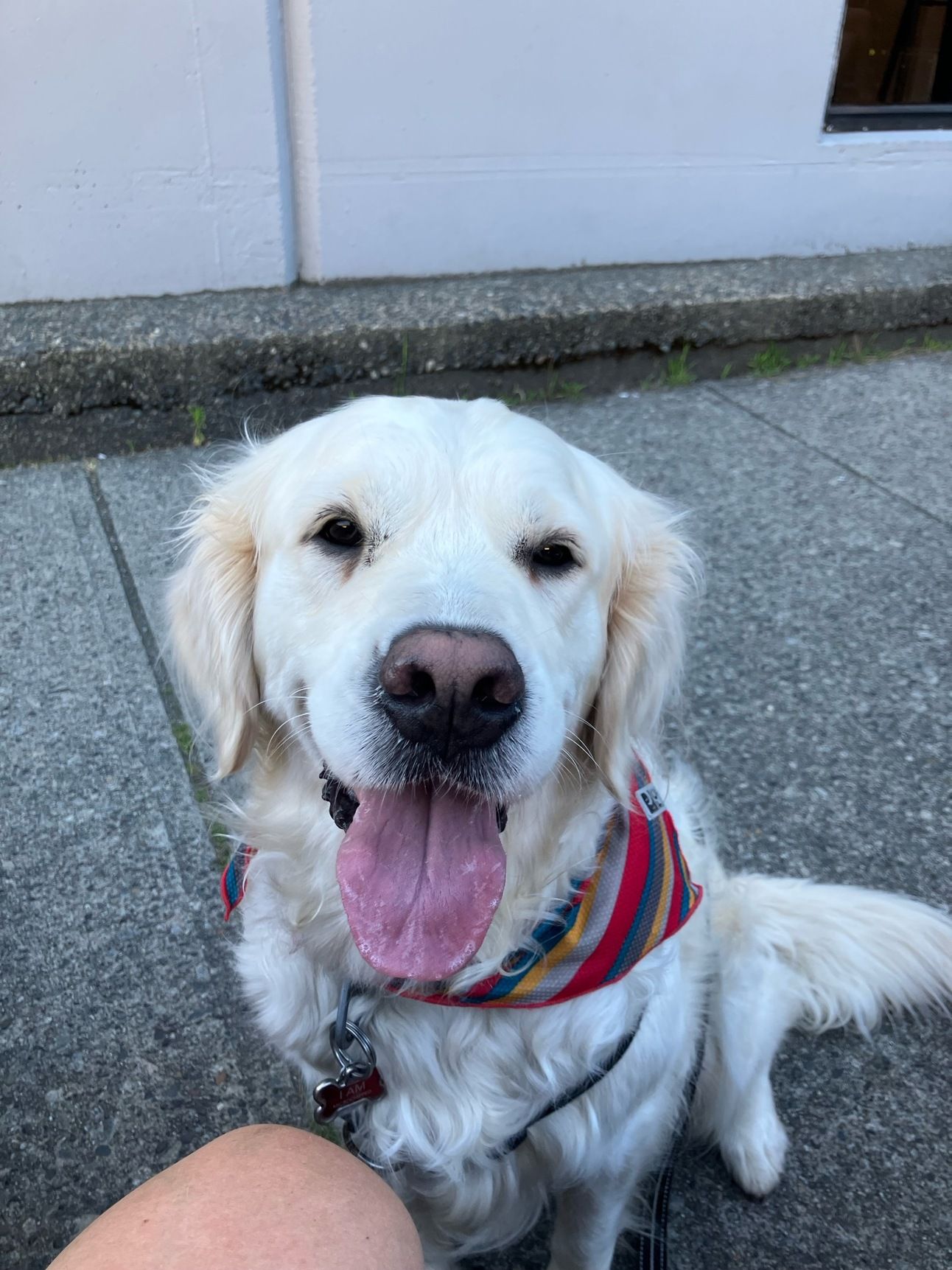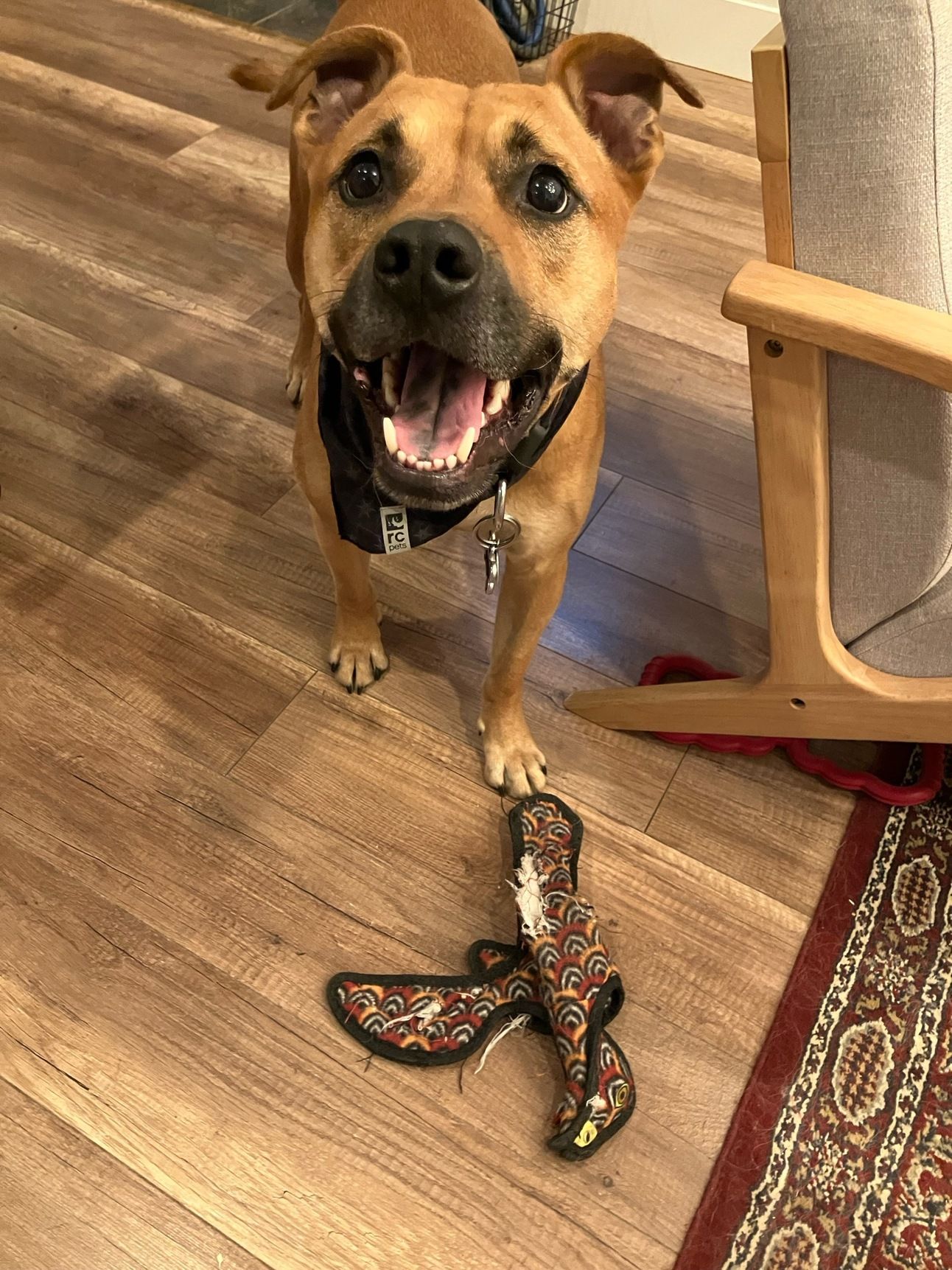- Rose-Coloured
- Posts
- A highly intellectual discussion on talking dogs
A highly intellectual discussion on talking dogs

This is a linguist-in-chief Anne-Michelle Tessier guest post, at last marrying her two true vocations, linguists and dogs (and I guess the third one too, which is interesting stories) for this fascinating discussion of when dogs use word buttons to communicate how that…works, exactly. And why it works. And what is going on? And stuff? She phrases the questions better, and then answers them. One of the reasons I first became friends with AMT is that she speaks with such passion and precision about her areas of expertise that you could easily think she’s a genius at everything (which is why I used to frequently ask for her help with my geography assignments, despite the fact that AMT never took geography and I minored in it; she respectfully declined; I still think she probably could have done it.) Anyway, this is a very smart and interesting post, and yet somehow also adorable.
One reason that science writing is really hard, I believe, is that expertise colours one’s perception of what is interesting. The fundamental reasons that I study child language acquisition are in some sense only interpretable to other linguists, because I’m trying to answer questions that a linguist would ask— questions whose answers can ultimately support or challenge linguistic theories, but won’t necessarily tell you anything else about children or English or the like.
How do I convince you that my linguist’s questions are interesting? In my observational experience, the answer is that I do not convince you! Theoretical linguists never succeed at this! (That’s why there’s only one famous theoretical linguist and he’s famous for his politics.) … Yet I still think it’s only fair if experts try to present scientific answers to lay readers in the context their authors intended, which means first explaining the questions.
So. I told Rebecca that I wanted to write a newsletter piece about dogs like Bunny and Stella, who are out here on social media pushing buttons to communicate with their humans. And fairly soon I realized that the things I am most interested in about dogs and buttons are not the things of interest to normal dog-interested people.
My first question out of the gate is: what do dogs actually perceive in a disembodied voice recording? It may not be clear to you that this is even a question?... but it requires several cognitive leaps to go from (1) a familiar human face’s mouth opens, and she says the name “BAGEL!” while reaching out her arms, smelling like familiarity and home, to (2) a slightly imperfect audio recording of “BAGEL!” is emitted from a button with no face, smell etc. Only if a dog can take those leaps can they ultimately interpret both (a) and (b) as having the same meaning. (And oh god, what is “meaning”?! About that, just keep reading.)
As it turns out, these first questions have been pretty successfully answered! That is: there is converging evidence that dogs can perceive (1) and (2) as similar enough to make button communication viable, and also that they can discern enough details in speech to treat their own name “BAGEL!” as different than, e.g., “BOOGEL!” There’s also more subtle, neurological evidence of these skills—meaning that dog brains show different activation patterns when listening to familiar commands vs. unknown words with the same overall sound shape (equivalent to e.g. “lay down!” vs. “moo peen!” – I say equivalent because this study used Hungarian dogs and Hungarian commands, but trust me.)
My second question is: what do we know about dogs’ abilities to understand human words at all? And one answer (that has just struck me embarrassingly recently) suggests a potential disconnect between child vs. dog comprehension of human words: namely words for things vs. words for actions.
Suppose I yell “DESERT VULTURE!” out of the blue at you (assuming you to be a typically hearing, English-speaking adult human). Whatever else my shriek prompts in you, you will know that what I’ve yelled refers to a thing. Precisely what I intended to do by yelling is another matter: I might be labeling a thing that’s over your shoulder; I might have just remembered the name for that thing on TV last night; I might be warning you to duck. But at some level, you know I’ve yelled a noun phrase; I didn’t yell a verb or verb phrase, like “catch!” or “run for your life!” or “check out this stuffed toy!”… In my house, “DESERT VULTURE!” probably indicates that the man of the house is throwing a toy for Howard, but that’s an inference I’ve learned to draw. I still know that “desert vulture” means something that’s a noun, not a verb.

Excited light brown dog with floppy toy that could, we suppose, conceivably be called “desert vulture.”
To ruthlessly summarize the results from entire subfields of philosophical speculation, developmental psychology and corpus linguistics: human children tend to learn noun meanings somewhat earlier and faster than verb meanings. … But with dog learners of human speech, it seems that the bias is the reverse?
In a programmatic article about studying dog-button communication, Bastos and Rossano (2023: 315) point out (bolding mine): “We do not currently know why only a minority of dogs… readily learn object referents, when most dogs can readily acquire action words. It may be that most dogs are simply less attentive to, or less interested in, objects or differences between object features, compared to differences between events or behaviours performed by themselves or their owners: a toy by any other name would be just as fun.” In other words: Howard may not care what his desert vulture stuffie is called, so long as it’s thrown when prompted. Perhaps, then, button-using dogs will be more interested in requesting the throwing than in labeling the vulture?
Recent controlled studies on that “minority of dogs who readily learn object referents” do tell us that these special dogs (who are very often, though not only, Border Collies…) can learn names for novel toys after hearing those names only a few times. However! This “fast mapping” learning appears to require social interaction with their human to learn the label—and it’s definitely only available for a minority of advanced dogs. There is even evidence that these good-at-noun-learning dogs are doing something cognitively special—for instance, they are statistically much more likely to tilt their head when being taught a novel object name, compared to your average pooch (see the adorable video in that last link…)
Now at long last, I get to the question of what words (via button-presses) dogs seem to produce the most often—and especially, what combinations of words. A big data science effort based at UC San Diego is just starting to publish studies, with preliminary but informative titles like 2024’s “Soundboard-trained dogs produce non-accidental, non-random and non-imitative two-button combinations”. Notably for me, the most common two-button combinations that dogs produce include FOOD+TREAT, and their own names plus WANT. … And so MY question is: are those nouns, or verbs, or something else? I doubt that most dogs are producing “food” and “treat” as mere commentary: “Oh look, there’s some food! Just wanted to alert you to the presence of food, nothing else you should read into this.” But if everything they are producing is a request (i.e., if ‘FOOD+TREAT’ really means “I want food/treats,” bringing with it some kind of silent verb) – then what does it mean when they explicitly press ‘WANT’?!
By now, you might be impatient that I haven’t asked exactly how people are teaching their dogs these button meanings. (This question might in fact be interesting to everyone.) The term adopted for such training is “modeling” – so, a human “models” the word OUTSIDE by saying the word, and opening the door to the backyard, then pressing the button that plays their voice recording of OUTSIDE, and opening the door to the backyard. When eventually their dog presses the OUTSIDE button, even accidentally, the human immediately and ostentatiously opens the door to the backyard. … And eventually, the dog comes to expect the backyard door to open when they press OUTSIDE.
But: what do they think OUTSIDE means? … Open the backdoor? Time to pee? Make it smell like the yard in here? Or a million other options?
And what about this video, where Bunny apparently presses MAD, OUCH, STRANGER, PAW to report that she has a thorn stuck in her paw… How did their human model MAD? And especially STRANGER?? And what could the dog possibly think those words mean?
… Still so, so many questions.
Updates when I figure out more about which ones are interesting.
Reply